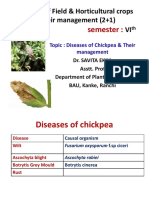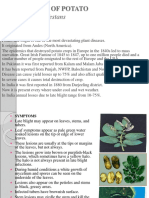Professional Documents
Culture Documents
Diseases of Gram
Uploaded by
Taushif AhammedCopyright
Available Formats
Share this document
Did you find this document useful?
Is this content inappropriate?
Report this DocumentCopyright:
Available Formats
Diseases of Gram
Uploaded by
Taushif AhammedCopyright:
Available Formats
Diseases of Gram
1. Alternaria blight: Alternaria alternata
2. Ascochyta blight: Ascochyta rabiei
3. Botrytis gray mold: Botrytis cineria
4. Collar rot: Sclerotium rolfsii
5. Dry root rot: Rhizoctonia bataticola/Macrophomina phaseolina
6. Fusarium wilt: Fusarium oxysporum f.sp.ciceri
7. Powdery mildew: Oidiopsis taurica
Ascochyta blight
• Economic importance: The disease can cause grain yield and quality losses up to 100%.
Symptoms:
Flowering and podding time is most susceptible and producing patches of
blighted plants.
The emerging seedlings develop dark brown lesions at the base of the stem.
Affected seedlings may collapse and die.
Pycnidia may be formed on the lesions.
On a susceptible cultivar, the necrosis progresses from the buds downwards,
killing the plant.
The fungus penetrates the pod and infects the developing seed.
Ascochyta blight symptoms on Gram
Dr. Arghya Banerjee, Assistant Professor (Plant Pathology), TNU
Causal organism:
Ascochyta rabiei (Pass.) Labr. [teleomorph: Didymella rabiei (Kovacheski)
von Arx (synonym: Mycosphaerella rabiei Kovacheski)], class
Dothideomycetes, order Pleosporales, family Didymellaceae.
The pycnidium was spherical or pear-shaped with an ostiole.
The conidia (8-15 × 4-6 µm) were oval to oblong, hyaline, occasionally bi-
celled, rounded at both ends
They developed on conidiophores and embedded in a mucilaginous mass
of cream-pink to light tan.
The fungus was flat, submerged with sparse mycelium on artificial media.
Bitunicate ascus and ascospores were produced by sexual stage of fungi,
Didymella rabiei
A-B. Growth on PDA, C. Pycnidium, D. Conidia of Ascochyta rabiei
Epidemiology:
Diseased debris left over in the fields also serves as a source of primary
inoculum.
Ascospores were also found to play a role in the initiation of disease epidemics.
Secondary spread is through pycnidiospores.
Cool, cloudy and wet weather favors the disease development.
The disease builds up and spreads fast when night temperatures are around 10°C,
day temperatures are around 20°C, and rains are accompanied by cloudy days.
Dr. Arghya Banerjee, Assistant Professor (Plant Pathology), TNU
Excessive canopy development also favors blight development.
Disease Cycle:
Disease Management:
Cultural practices: Sow late, remove and destroy dead plant debris, rotate crops, sow
deep (15 cm or deeper), wider row spacing, adopt low seeding rate, intercrop with wheat,
barley, mustard, bury diseased debris 10 cm or deeper, sow disease-free seeds
Resistant varieties/lines: F8, C 12/34, C 235, G 543, H 75-35, GG688,GNG
146,Gaurav, BG 261, GG 588,Hima chana-1, Gaurav, Vardan, Samrat, PBG 1 and BG
261
Chemical: Seed treatment: Azoxistrobin @ 1g/kg , Benomyl @ 2 g/kg , Calixin M®
(tridemorph + maneb) @ 3 g/kg , Calixin M® (tridemorph + maneb) + thiram (1:1) @ 2-
5 g/kg Foliar application: chlorothalonil, Wettable sulphur, dithianon (Dosage @ 3 g/l)
Dr. Arghya Banerjee, Assistant Professor (Plant Pathology), TNU
Extracts from cultures of Aspergillus parasiticus are active against A. rabiei.
Botrytis gray mold (BGM)
• Economic importance: BGM can cause yield losses up to 100%.
Symptoms:
Lack of pod setting is the first indication of the disease
Plants often die in patches
The disease is more severe on portions of the plant hidden under the canopy
When humidity is very high, the symptoms appear on stems, leaves, flowers
and pods as gray or dark brown lesions covered with moldy sporophores.
Lesions on stem are 10 - 30 mm long and girdle the stem completely
Lesions on the pod are water-soaked and irregular
Grayish white mycelium may be seen on the infected seeds.
Botrytis gray mold symptoms on Gram
Epidemiology:
The disease is usually seen at flowering time when the crop canopy is fully
developed.
Excessive vegetative growth due to too much irrigation or rain, close
spacing, and varieties that have a spreading habit favor disease
development.
Temperatures between 20 and 25°C and excessive humidity around flowering
and podding time favor disease development.
Dr. Arghya Banerjee, Assistant Professor (Plant Pathology), TNU
Disease Cycle:
Disease Management:
Cultural practices: Use disease-free seed, burn infected debris, deep ploughing, adopt
late sowing and wider row spacing, intercrop with linseed or wheat, avoid excessive
vegetative growth, avoid excessive irrigation.
Resistant varieties/lines: BG 276, GL 90159, GL 91040, GL 91071 and GL 92162
Chemical: Seed treatment: carbendazim + thiram (1:1) vinclozolin, carbendazim
triadimefon, Dithane M 45® (maneb) Triadimenol, thiabendazole, iprodione
Foliar spray: vinclozolin
carbendazim @ 1g/L + thiram @ 2g/L
carbendazim @1 g/L , captan
Chlorothalonil, mancozeb, thiophonate methyl (Apply at 50 days after sowing or at the
first sign of symptoms)
Dr. Arghya Banerjee, Assistant Professor (Plant Pathology), TNU
Wilt disease
• Economic importance: Yearly yield losses are estimated at 10-15% in India and
Spain, with losses of 70-100% in years of severe outbreaks of the disease.
Symptoms:
Seedling stage
The disease can be observed within 3 weeks of sowing.
Whole seedlings (3 - 5 weeks after sowing) collapse and lie flat on the ground.
When uprooted, they usually show uneven shrinking of the stem above and
below the collar region (soil level).
Dark brown to black discoloration of the internal stem tissues is clearly visible
Adult stage
The affected plants show typical wilting, ie, drooping of the petioles, rachis and
leaflets
Drooping is visible initially in the upper part of the plant but within a day or two,
the entire plant droops.
The lower leaves are chlorotic, but most of the other leaves droop while still
green.
Gradually, however, all the leaves turn yellow and then light brown or straw
colored.
When the stem is split vertically, internal discoloration can be seen. Around the
collar region, above and below, the xylem in the central inner portion (pith and
part of the wood) is discolored dark brown or black.
Dr. Arghya Banerjee, Assistant Professor (Plant Pathology), TNU
Wilt disease symptoms on Gram
Causal organism:
The disease is caused by Fusarium oxysporum f.sp. ciceri, producing macro and
micro conidia. Chlamydospores often produced by pathogen.
a) Microconidia, b) Macroconodia produced by Fusarium oxysporum
f.sp. ciceri, a) Chlamydospore, b) Mycelium
Epidemiology:
Wilt is a seed and soil borne disease.
Wilt incidence is generally higher when chickpea is grown in warmer and
drier climates (> 25°C) and when crop rotations are not practiced.
Disease Cycle:
Dr. Arghya Banerjee, Assistant Professor (Plant Pathology), TNU
Disease Management:
Cultural practices: Use disease-free seed, avoid sowing when temperatures are high
(late sowing), follow 4-year crop rotations, soil solarization during summer months,
Green manuring/ FYM application
Resistant varieties/lines: No. 10, S 26, G 24, C 214, BG 244, Pusa212, Avrodhi, JG 315,
JG 14, JG 11, JGK 2,KAK 2, Vijay, Vaibhav, JG 63, Birsa canna-3, WR 315, JG 74,
JAKI 9218, Vihar, JG 1265,BG 1053, PDG 4, Gujarat gram 4, Gujaratgram 1, BGM 47,
COG 29-1, L551
Chemical: Seed treatment with Bavistin @2g/kg of seed or carbendazim
Biological: Seed treatment with Trichoderma viridae @4g/kg or Pseudomonas
fluorescence @10 g/kg
Dr. Arghya Banerjee, Assistant Professor (Plant Pathology), TNU
You might also like
- Fungi of Medical ImportanceDocument11 pagesFungi of Medical ImportanceRi FitrianaNo ratings yet
- Diseases, Insects and Spraying Fruit Trees in the OrchardFrom EverandDiseases, Insects and Spraying Fruit Trees in the OrchardNo ratings yet
- Diseases and Pests of Mushrooms and Other Fungi - With Chapters on Disease, Insects, Sanitation and Pest ControlFrom EverandDiseases and Pests of Mushrooms and Other Fungi - With Chapters on Disease, Insects, Sanitation and Pest ControlNo ratings yet
- Cassava and Yam Production and Management TecnoguideDocument16 pagesCassava and Yam Production and Management TecnoguideEric D. ValleNo ratings yet
- Lesson Plan in FungiDocument6 pagesLesson Plan in FungiRico FernandezNo ratings yet
- Diseases of Field Crops and Their Management PDFDocument198 pagesDiseases of Field Crops and Their Management PDFjahangir khanNo ratings yet
- Wheat Diseases and Pests: A Guide For Field IdentificationDocument147 pagesWheat Diseases and Pests: A Guide For Field IdentificationInternational Maize and Wheat Improvement Center100% (1)
- Tbi-Tnau-Incubatees List (Mushroom Venture) Sl. No Name of The Incubatee & Company Contact Number Email ProductDocument3 pagesTbi-Tnau-Incubatees List (Mushroom Venture) Sl. No Name of The Incubatee & Company Contact Number Email Productpraveenramanujam100% (1)
- Study material For PPATH-312Document92 pagesStudy material For PPATH-312demonkingf6No ratings yet
- Diseases of PeaDocument7 pagesDiseases of PeaTaushif AhammedNo ratings yet
- APP-312: Manage Rice Diseases Like Blast, Brown Spot & Sheath BlightDocument7 pagesAPP-312: Manage Rice Diseases Like Blast, Brown Spot & Sheath BlightRudal ThakurNo ratings yet
- Diseases of Chickpea PDFDocument19 pagesDiseases of Chickpea PDFrahul100% (1)
- Lec07 PDFDocument24 pagesLec07 PDFSayan royNo ratings yet
- PP-202 Week 8Document4 pagesPP-202 Week 8Yasir IftikharNo ratings yet
- 9Document195 pages9Mahes MaityNo ratings yet
- Gram DiseasesDocument12 pagesGram DiseasesKabeer NNo ratings yet
- Tomato DiseaeseDocument11 pagesTomato DiseaeseHassenNo ratings yet
- Diseases of RiceDocument7 pagesDiseases of RiceMuneef VkNo ratings yet
- Pathology Plant DiseasesDocument36 pagesPathology Plant DiseasesGary Bhullar100% (3)
- Management of Diseases of Important Agriculture Crops of Tamil NaduDocument43 pagesManagement of Diseases of Important Agriculture Crops of Tamil NaduVishnuvardhan RavichandranNo ratings yet
- Diseases of PotatoDocument8 pagesDiseases of PotatoAkash RoyNo ratings yet
- Diseases of PotatoDocument8 pagesDiseases of PotatoAkash RoyNo ratings yet
- Majordiseasesofchilli 120424055536 Phpapp01Document22 pagesMajordiseasesofchilli 120424055536 Phpapp01Subbu YadavNo ratings yet
- Faculty of Agricultural Sciences and Allied Industries Diseases of Field&Horticultural Crops& Management 1 PPA - 312Document8 pagesFaculty of Agricultural Sciences and Allied Industries Diseases of Field&Horticultural Crops& Management 1 PPA - 312Aalok MishraNo ratings yet
- IPM SCHEDULE FOR GUAVA PESTSDocument21 pagesIPM SCHEDULE FOR GUAVA PESTSpegasus86843No ratings yet
- Plant Diseases IV (VI Sem)Document14 pagesPlant Diseases IV (VI Sem)hambardevishnu2No ratings yet
- Diseases of Chilli - Damping off, Fruit Rot, Powdery Mildew, Bacterial Leaf SpotDocument8 pagesDiseases of Chilli - Damping off, Fruit Rot, Powdery Mildew, Bacterial Leaf SpotIll DuceNo ratings yet
- Disease of ChilliDocument8 pagesDisease of ChilliSourabh PatilNo ratings yet
- SmutDocument16 pagesSmutRohith GandhiNo ratings yet
- LET'S TALK ABOUT Fungi! - 2 SAJIDDocument9 pagesLET'S TALK ABOUT Fungi! - 2 SAJIDgrrafi17No ratings yet
- Maize? DeseaseDocument22 pagesMaize? DeseaseRudal ThakurNo ratings yet
- Mycoplasma/Phytoplama (PPLO) Diseases of Plants: Citrus Greening, Rice Yellow Dwarf: Little Leaf of Brinjal, Sandal SpikeDocument11 pagesMycoplasma/Phytoplama (PPLO) Diseases of Plants: Citrus Greening, Rice Yellow Dwarf: Little Leaf of Brinjal, Sandal SpikeSwapnil BahekarNo ratings yet
- 8 Plant Clinic Management in Different Crops of RajasthanDocument19 pages8 Plant Clinic Management in Different Crops of RajasthanSamuel DavisNo ratings yet
- Late Blight of PotatoDocument20 pagesLate Blight of PotatoShaik Gouse BashaNo ratings yet
- Post Harvest Diseases of CearealsDocument6 pagesPost Harvest Diseases of CearealsZahwa AshfaqueNo ratings yet
- Common Pests and DiseasesDocument209 pagesCommon Pests and DiseasesRenalyn Ignacio DapiaoenNo ratings yet
- Corn DiseasesDocument46 pagesCorn DiseasesMandre DynaNo ratings yet
- Banana Disease 2 PDFDocument4 pagesBanana Disease 2 PDFAlimohammad YavariNo ratings yet
- 28 Soybean DiseasesDocument2 pages28 Soybean Diseasesculis_chem07No ratings yet
- Disease of Pearl MilletDocument26 pagesDisease of Pearl MilletLitty LazarNo ratings yet
- Diseases of Passion FruitDocument18 pagesDiseases of Passion FruitRija Parfait RANDRIANANDRASANANo ratings yet
- PP-202 Week 6Document5 pagesPP-202 Week 6Yasir IftikharNo ratings yet
- PAT 577 Assignment On Diseases of BajraDocument17 pagesPAT 577 Assignment On Diseases of BajraSree Naveena100% (1)
- Enfermedades Foliares en MaizDocument26 pagesEnfermedades Foliares en MaizgegarborNo ratings yet
- Phytophthora Infestans: Late Blight of PotatoDocument9 pagesPhytophthora Infestans: Late Blight of PotatoHaider ALiNo ratings yet
- Cotton Diseases Handout EnglishDocument6 pagesCotton Diseases Handout Englishusama_yasinNo ratings yet
- Disease Competitor Moulds Dr. S.R. Sharma PDFDocument86 pagesDisease Competitor Moulds Dr. S.R. Sharma PDFIndra-Astral PemulaNo ratings yet
- Practical Manual Field DiseasesDocument91 pagesPractical Manual Field DiseasesDr. Uzma KhanNo ratings yet
- Major Forest DiseaseDocument31 pagesMajor Forest DiseaseGolam DastogeerNo ratings yet
- Boli Cu Poze Floarea SoareluiDocument10 pagesBoli Cu Poze Floarea SoareluiAndrea HernandezNo ratings yet
- IPM for Vegetable Pests & DiseasesDocument53 pagesIPM for Vegetable Pests & DiseasesLeocarl Fabunan Simon RANo ratings yet
- Foliar Diseases of TomatoDocument4 pagesFoliar Diseases of TomatoSharad BhutoriaNo ratings yet
- Seed Health TechnologyDocument42 pagesSeed Health TechnologyMuhammad Boota Sarwar80% (10)
- AGS 322 Diseases of Field Crops and Their ManagementDocument54 pagesAGS 322 Diseases of Field Crops and Their ManagementNavneet KumarNo ratings yet
- Diseases of Okra and Bean ReportDocument17 pagesDiseases of Okra and Bean ReportShubham ChauhanNo ratings yet
- Pub 3084 Rice Disease Slow ResDocument6 pagesPub 3084 Rice Disease Slow Reslynmaria madronaNo ratings yet
- Antrachnose of Chili and Its ControlDocument8 pagesAntrachnose of Chili and Its Controlgreen tulipNo ratings yet
- Bacterial Diseases in Plants-302Document8 pagesBacterial Diseases in Plants-302sidhubs04No ratings yet
- Diseases of RiceDocument40 pagesDiseases of RiceShaik Gouse BashaNo ratings yet
- Gram Disease atDocument7 pagesGram Disease atwodab95256No ratings yet
- onionandgarlic-160831061046Document36 pagesonionandgarlic-160831061046dawit gNo ratings yet
- Pests of PaddyDocument19 pagesPests of PaddyPurushotham PaspuletiNo ratings yet
- IDMDocument7 pagesIDMJayshree Borah50% (2)
- 1st Lecture ABMDocument5 pages1st Lecture ABMTaushif AhammedNo ratings yet
- 2nd LectureDocument3 pages2nd LectureTaushif AhammedNo ratings yet
- Problems and Prospects of Rainfed Agriculture in IndiaDocument20 pagesProblems and Prospects of Rainfed Agriculture in IndiaTaushif Ahammed0% (1)
- FSN Lecture - 3 (Class Notes)Document3 pagesFSN Lecture - 3 (Class Notes)Taushif AhammedNo ratings yet
- Diseases of CoconutDocument16 pagesDiseases of CoconutTaushif AhammedNo ratings yet
- Objectives: Lab. Activity 1: Spontaneous GenerationDocument3 pagesObjectives: Lab. Activity 1: Spontaneous GenerationPipay AllenaNo ratings yet
- Colony PCRDocument10 pagesColony PCRClaudia NatalicaNo ratings yet
- TuronDocument6 pagesTuronAnn NavarroNo ratings yet
- 0.4 Index 2016 The Fungi Third EditionDocument19 pages0.4 Index 2016 The Fungi Third EditionMuhammad Ali Al HakimNo ratings yet
- Barnet & Hunter Illustrated Genera of Imperfect FungiDocument234 pagesBarnet & Hunter Illustrated Genera of Imperfect FungioktaviashintaNo ratings yet
- 356-Article Text-811-1-10-20190712Document6 pages356-Article Text-811-1-10-20190712Sagita PutriNo ratings yet
- Submerged Culture of The Mycelium of Various Species of MushroomDocument3 pagesSubmerged Culture of The Mycelium of Various Species of Mushroombravohr98No ratings yet
- 2Document7 pages2Shubham SinghNo ratings yet
- AntifungiDocument11 pagesAntifungiIdkNo ratings yet
- (DERMA) 03 TineasDocument9 pages(DERMA) 03 TineasJolaine ValloNo ratings yet
- POSTULADOS GUIA - Ashby - BMS - Koch's Postulates For Plant PathogensDocument6 pagesPOSTULADOS GUIA - Ashby - BMS - Koch's Postulates For Plant PathogensAlfredo Zegarra MaizNo ratings yet
- MYCOLOGYDocument7 pagesMYCOLOGYJeremiahNo ratings yet
- IJTK SupplementaryDocument9 pagesIJTK SupplementaryNastySon FootNimbusNo ratings yet
- The Hereford Fungus EatersDocument6 pagesThe Hereford Fungus Eatersj. l. hooverNo ratings yet
- ZW 04 2021 04Document8 pagesZW 04 2021 04Aleksandra RuszewskaNo ratings yet
- Diseases of GramDocument8 pagesDiseases of GramTaushif AhammedNo ratings yet
- Superficial Fungal Disorders of The SkinDocument121 pagesSuperficial Fungal Disorders of The SkinhaniNo ratings yet
- Medical Microbiology Mycoses ClassificationDocument7 pagesMedical Microbiology Mycoses ClassificationAisha Nur Ashri WidyaNo ratings yet
- Major Diseases of Sorghum and Bajra.: C O Llege of Agriculture, RaipurDocument14 pagesMajor Diseases of Sorghum and Bajra.: C O Llege of Agriculture, RaipurVed MehraNo ratings yet
- K7 Jamur Superficial 2020Document51 pagesK7 Jamur Superficial 2020Jimmy Fran IINo ratings yet
- Single Spore Isolation of Fungi PDFDocument10 pagesSingle Spore Isolation of Fungi PDFNguyễn Vương TuấnNo ratings yet
- Aspergillusspp 160418120212Document8 pagesAspergillusspp 160418120212JUAN HERNANDEZNo ratings yet
- Introduction To MycologyDocument18 pagesIntroduction To Mycologyapi-19969058100% (1)
- INFECTII FUNGICE - Dermatofitii, factori favorizanti, clasificare, tinea corporis, cruris, faciei, manum, pedis, pilomicoze, onicomicozeDocument13 pagesINFECTII FUNGICE - Dermatofitii, factori favorizanti, clasificare, tinea corporis, cruris, faciei, manum, pedis, pilomicoze, onicomicozeMaria SolomonNo ratings yet
- Flip Top Cap MouldDocument1 pageFlip Top Cap Mouldamira malik12No ratings yet
- Is48 Fungicide Activity and Performance in WheatDocument6 pagesIs48 Fungicide Activity and Performance in WheatRadu GheorgheNo ratings yet
- "Diseases Caused by Candida Albicans in HumanDocument6 pages"Diseases Caused by Candida Albicans in HumanLucky studio.LUQMAN KHAN.No ratings yet






























































































